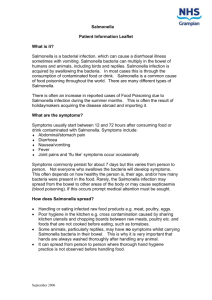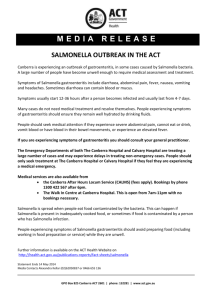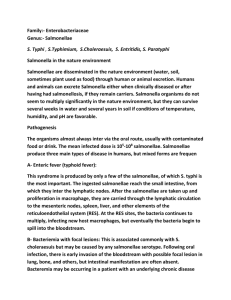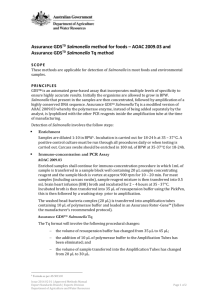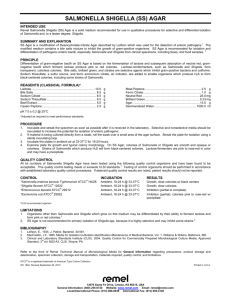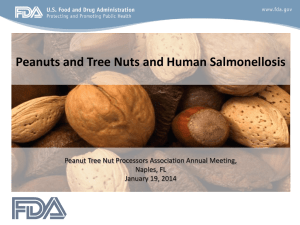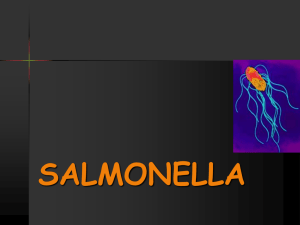Reduction of Fecal Microbes by Wastewater Treatment
advertisement
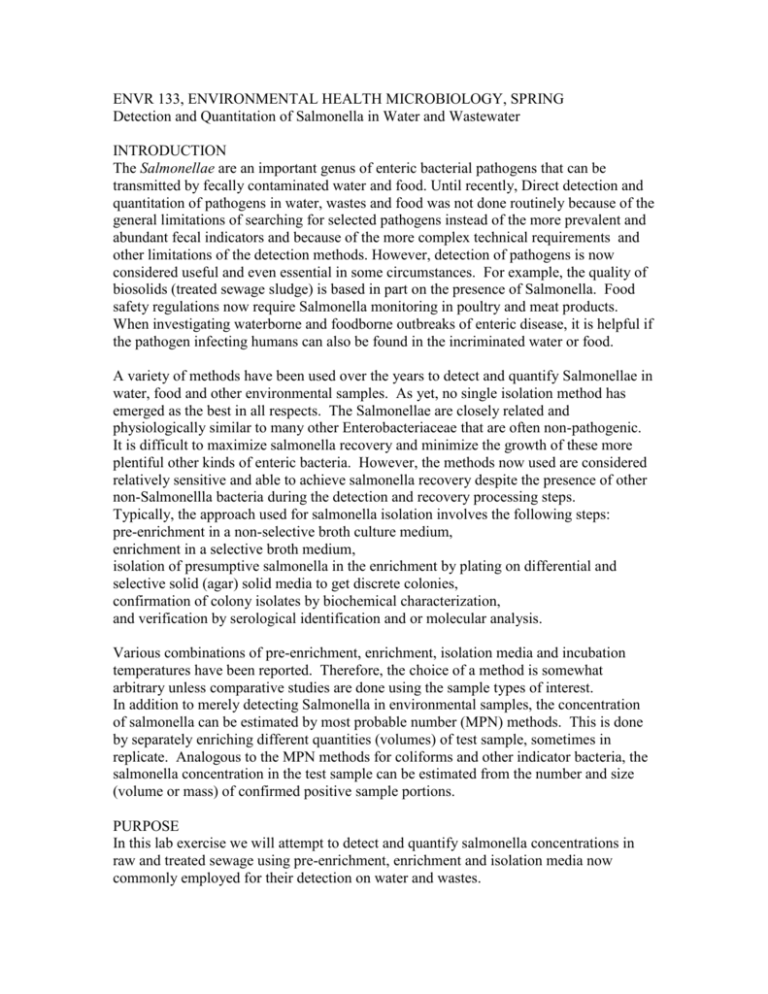
ENVR 133, ENVIRONMENTAL HEALTH MICROBIOLOGY, SPRING Detection and Quantitation of Salmonella in Water and Wastewater INTRODUCTION The Salmonellae are an important genus of enteric bacterial pathogens that can be transmitted by fecally contaminated water and food. Until recently, Direct detection and quantitation of pathogens in water, wastes and food was not done routinely because of the general limitations of searching for selected pathogens instead of the more prevalent and abundant fecal indicators and because of the more complex technical requirements and other limitations of the detection methods. However, detection of pathogens is now considered useful and even essential in some circumstances. For example, the quality of biosolids (treated sewage sludge) is based in part on the presence of Salmonella. Food safety regulations now require Salmonella monitoring in poultry and meat products. When investigating waterborne and foodborne outbreaks of enteric disease, it is helpful if the pathogen infecting humans can also be found in the incriminated water or food. A variety of methods have been used over the years to detect and quantify Salmonellae in water, food and other environmental samples. As yet, no single isolation method has emerged as the best in all respects. The Salmonellae are closely related and physiologically similar to many other Enterobacteriaceae that are often non-pathogenic. It is difficult to maximize salmonella recovery and minimize the growth of these more plentiful other kinds of enteric bacteria. However, the methods now used are considered relatively sensitive and able to achieve salmonella recovery despite the presence of other non-Salmonellla bacteria during the detection and recovery processing steps. Typically, the approach used for salmonella isolation involves the following steps: pre-enrichment in a non-selective broth culture medium, enrichment in a selective broth medium, isolation of presumptive salmonella in the enrichment by plating on differential and selective solid (agar) solid media to get discrete colonies, confirmation of colony isolates by biochemical characterization, and verification by serological identification and or molecular analysis. Various combinations of pre-enrichment, enrichment, isolation media and incubation temperatures have been reported. Therefore, the choice of a method is somewhat arbitrary unless comparative studies are done using the sample types of interest. In addition to merely detecting Salmonella in environmental samples, the concentration of salmonella can be estimated by most probable number (MPN) methods. This is done by separately enriching different quantities (volumes) of test sample, sometimes in replicate. Analogous to the MPN methods for coliforms and other indicator bacteria, the salmonella concentration in the test sample can be estimated from the number and size (volume or mass) of confirmed positive sample portions. PURPOSE In this lab exercise we will attempt to detect and quantify salmonella concentrations in raw and treated sewage using pre-enrichment, enrichment and isolation media now commonly employed for their detection on water and wastes. MATERIALS Samples: Raw sewage and treated sewage and upstream and downstream samples from Morgan Creek receiving water. Pre-enrichment medium: buffered peptone water. Enrichment medium: Rappaport-Vassiliadis broth. Colony isolation medium: Salmonella-Shigella agar Purification and storage medium: tryptic soy agar slants. Confirmatory biochemical tests: Enterotube biochemical test kit Work in pairs of two students Obtain samples of raw or treated sewage and a water sample (up- or down-stream as directed by the instructor. Mix the sample 25 times before removing aliquots. For up- and down-stream and treated sewage effluent samples, add 100 ml and 10 ml of sample to another 1 liter and 100 ml of BPW, respectively. For raw sewage, add 100, 10 ml, and 1 ml of sample to 1 liter, 100ml and 10 ml of BPW, respectively. Incubate samples at 37oC overnight (preferably <18 hr.). After incubation, transfer 1 ml of each pre-enrichment volume to 10 ml of each R-V medium as directed by the instructor. Incubate R-V enrichments at 43 oC for 24 hours. Streak from each enrichment onto SS agar and incubate overnight at 41oC and look for typical salmonella colonies. Appearance Likely Bacterium Colorless and translucent Salmonella and Shigella Translucent with black center Salmonella and Proteus Ping to red E. coli Pink to white, cream colored, opaque or mucoid Non-E. coli coliforms The number of colonies picked from initial SS agar plates depends on the number available, the amount of confirmatory media available and your ambition. Pick at least two typical colonies from each type of plate for each sample dilution, if they are present. Pick presumptive salmonella colonies, re-streak on SS-agar and incubate overnight at 37oC. Observe for typical Salmonella colonies on the re-streak plates. Pick these colonies, streaked onto tryptic soy agar slants and incubate overnight at 37oC. Then, store slants of presumptive Salmonella at 4oC for further biochemical analysis in a future lab period. Salmonella typhimurium (left) Salmonella Dublin (right)


